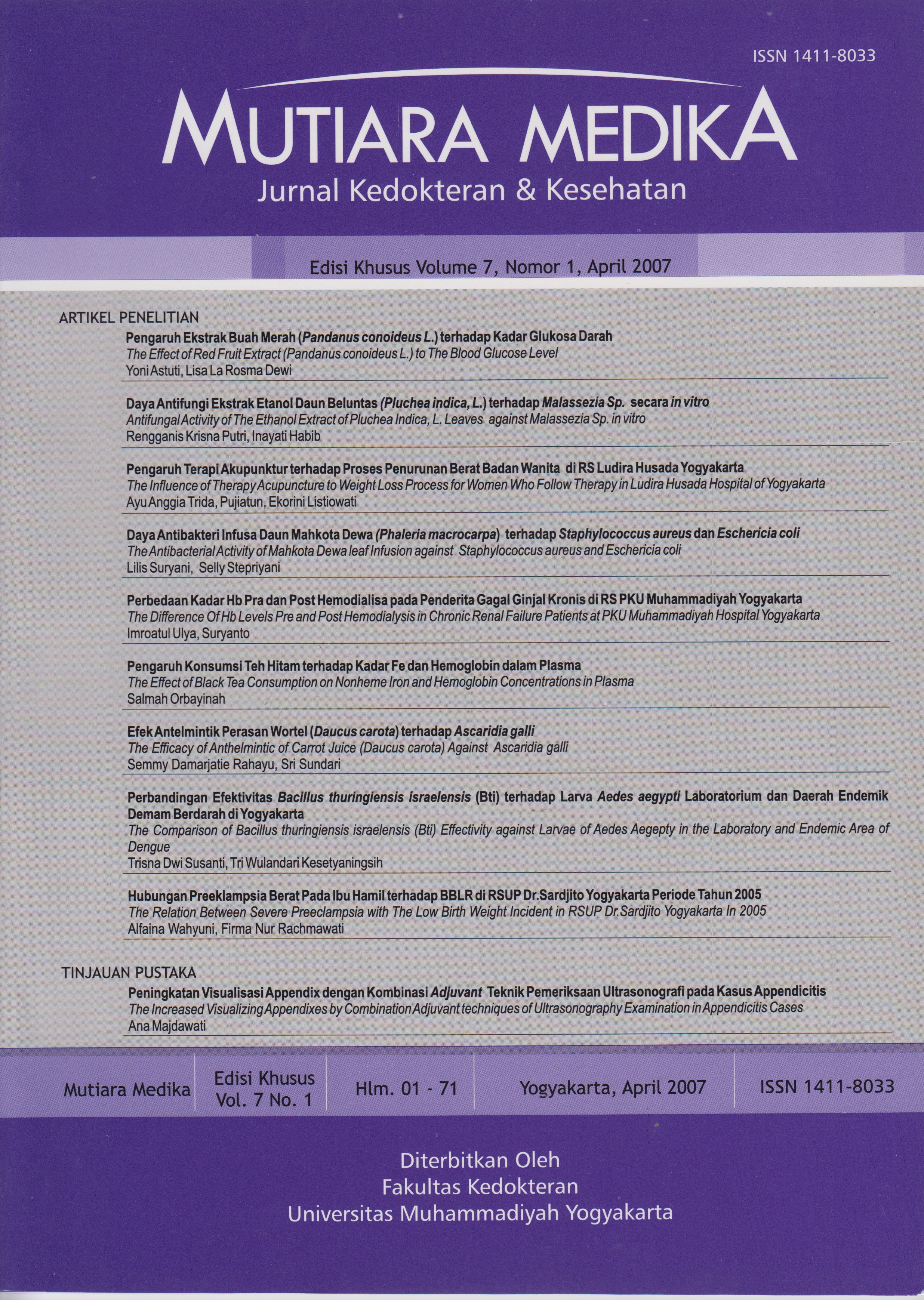Daya Antibakteri Infusa Daun Mahkota Dewa (Phaleria macrocarpa) terhadap Staphylococcus aureus dan Eschericia coli
DOI:
https://doi.org/10.18196/mmjkk.v7i1%20(s).1680Keywords:
mahkota dewa, daya antibakteri, Staphylococcus aureus, Escherichia coli, Phaleria macrocarpa, antibacterialAbstract
Mahkota dewa (Phaleria macrocarpa) from the little that is known as the Mahkota dewa of efficacy in treating various diseases, among others: pain heart, kidney, hypertension, heart disease, diabetes, rheumatism, arthritis and bacterial infectious diseases such as acne, eczema secondary infections, dysentery , cough, and fever. Part of this plant is the most widely used is the leaves, and processing techniques become more advanced with the various forms ofpackaging that facilitates the use by the public. Product packaging can be a form of instant, ingredients, capsules, and ointments. Mahkota dewa effective as analgesic, antibacterial, and antihistamines. This research was conducted to determine the antibacterial infusion god petals of various pathogens such as Staphylococcus aureus and Escherichia coli. Design of research is an experimental laboratory. Antibacterial activity is determined by applying the MIC (minimum inhibitory concentration) and MBC (minimum bacterisid concentration) by Tube Dilution Method. The bacteria test including Staphylococcus aureus ATCC 25933 and Escherichia coli strain ATCC 25922. The results showed that Mahkota dewa infusion has antibacterial activity against Staphylococcus aureus with MIC 3,125 gr % andMBC 6.25 gr %. Mahkota dewa leaf infusion does not have the antibacterial activity against Eschericia coli with MIC andMBC more than 25 g%.
Mahkota dewa (Phaleria macrocarpa) mulai banyak dikenal orang seiring dengan khasiat mahkota dewa dalam mengobati berbagai penyakit antara lain: sakit liver, ginjal, hipertensi, jantung, kencing manis, asam urat, rematik dan penyakit-penyakit infeksi bakterial seperti: jerawat, infeksi sekunder pada eksim, disentri, batuk, dan demam. Bagian dari tanaman ini yang paling banyak digunakan adalah daunnya, dan teknik pengolahannya pun semakin maju dengan berbagai bentuk kemasan yang mempermudah pemakaian oleh masyarakat. Kemasan produk dapat berupa bentuk instan, racikan, kapsul, dan minyak gosok. Daun mahkota dewa berkhasiat sebagai obat analgesik, antibakteri, dan antihistamin. Penelitian ini dilakukan untuk mengetahui daya antibakteri infusa daun mahkota dewa terhadap berbagai kuman patogen seperti Staphylococcus aureus dan Escherichia coli. Desain penelitian adalah eksperimental laboratorium. Aktivitas antibakteri ditentukan dengan menghitung KHM (kadar hambat minimal) dan KBM (kadar bunuh minimal) dengan metode seri pengenceran tabung (Tube Dilution Method). Bakteri uji yang digunakan meliputi Staphylococcus aureus ATCC 25933 dan Escherichia coli strain ATCC 25922. Hasil penelitian menunjukkan bahwa infusa daun mahkota dewa memiliki daya antibakteri terhadap Staphylococcus aureus dengan KHM 3,125 gram% dan KBM 6,25 gram%. Infusa daun mahkota dewa tidak memiliki daya antibakteri terhadap Eschericia coli dengan KHM lebih besar dari 25 gram%. Dapat disimpulkan bahwa infusa daun mahkota dewa bersifat bakterida terhadap bakteri Staphylococcus aureus.
References
Anonim , 2002, Mahkota Dewa, www.suaramerdeka.com
Harmanto, Ning, 2001, Mahkota Dewa- Obat Pusaka Para Dewa, Agro Media Pustaka, Jakarta
Harmanto, Ning, 2003, Menaklukkan Penyakit Bersama Mahkota Dewa, Agro Media Pustaka, Jakarta
Departemen Kesehatan, 1999, Inventaris Tanaman Obat Indonesia, Edisi V, Badan Litbang Kesehatan , Bakti Husada , Jakarta
Siswandono dan Soekarjo B, (1995), Kimia Medisinal, Airlangga University, Surabaya
Mutschler, E., 1991, Dinamika Obat, diterjemahkan oleh Mathilda B, Widiarto & Anna Setiadi Ranti, edisi V, Penerbit ITB, Bandung, 664-7
Ernest, J., 1996, Mikrobiologi Kedokteran, Edisi 20, EGC, Jakarta
Downloads
Published
Issue
Section
License
Copyright
Authors retain copyright and grant Mutiara Medika: Jurnal Kedokteran dan Kesehatan (MMJKK) the right of first publication with the work simultaneously licensed under an Attribution 4.0 International (CC BY 4.0) that allows others to remix, adapt and build upon the work with an acknowledgment of the work's authorship and of the initial publication in Mutiara Medika: Jurnal Kedokteran dan Kesehatan (MMJKK).
Authors are permitted to copy and redistribute the journal's published version of the work (e.g., post it to an institutional repository or publish it in a book), with an acknowledgment of its initial publication in Mutiara Medika: Jurnal Kedokteran dan Kesehatan (MMJKK).
License
Articles published in the Mutiara Medika: Jurnal Kedokteran dan Kesehatan (MMJKK) are licensed under an Attribution 4.0 International (CC BY 4.0) license. You are free to:
- Share — copy and redistribute the material in any medium or format.
- Adapt — remix, transform, and build upon the material for any purpose, even commercially.
This license is acceptable for Free Cultural Works. The licensor cannot revoke these freedoms as long as you follow the license terms. Under the following terms:
Attribution — You must give appropriate credit, provide a link to the license, and indicate if changes were made. You may do so in any reasonable manner, but not in any way that suggests the licensor endorses you or your use.
- No additional restrictions — You may not apply legal terms or technological measures that legally restrict others from doing anything the license permits.



